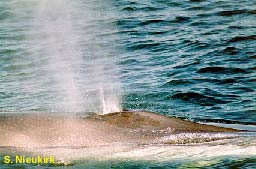| . |
 Fin
Whale Fin
Whale
Balaenoptera physalus
{Federally endangered species}
The
fin whale, Balaenoptera physalus, is the second largest
of the cetaceans, reaching lengths of 24 m (Leatherwood et
al. 1976) and weighing up to 73 MT (Minasian et al.
1984). These "greyhounds of the sea" are among the
fastest of the baleen whales, and are reported to swim at speeds
approaching 20 kt. For this reason, they became a commercially
important species only after the development of fast catcher
boats and the depletion of other large species such as the right
whale and blue whale (Leatherwood et al. 1976).
 Fin
whales have long slender bodies that are primarily dark gray
or brown in color. The ventral sides of the belly, flukes,
and flippers are white. Fin whales can be identified individually
by their natural marks and scars. Distinctive features include
the tall falcate dorsal fin, the light pigmentation or blaze
on the right side of the head, and the V-shaped gray-white
chevron on the back and sides (Agler et al. 1990).
The right side of the head, lower lip, upper lip, and a portion
of the baleen are white, whereas the entire left side of the
head is dark in color. It has been hypothesized that this
coloration is a feeding-related adaptation (Katona et
al. 1993). However, to date there is no evidence of this
(Tershey and Wiley 1992). Fin whale prey includes schooling
fish, euphausids, and copepods (Mitchell 1975). Fin
whales have long slender bodies that are primarily dark gray
or brown in color. The ventral sides of the belly, flukes,
and flippers are white. Fin whales can be identified individually
by their natural marks and scars. Distinctive features include
the tall falcate dorsal fin, the light pigmentation or blaze
on the right side of the head, and the V-shaped gray-white
chevron on the back and sides (Agler et al. 1990).
The right side of the head, lower lip, upper lip, and a portion
of the baleen are white, whereas the entire left side of the
head is dark in color. It has been hypothesized that this
coloration is a feeding-related adaptation (Katona et
al. 1993). However, to date there is no evidence of this
(Tershey and Wiley 1992). Fin whale prey includes schooling
fish, euphausids, and copepods (Mitchell 1975).
|
. |

